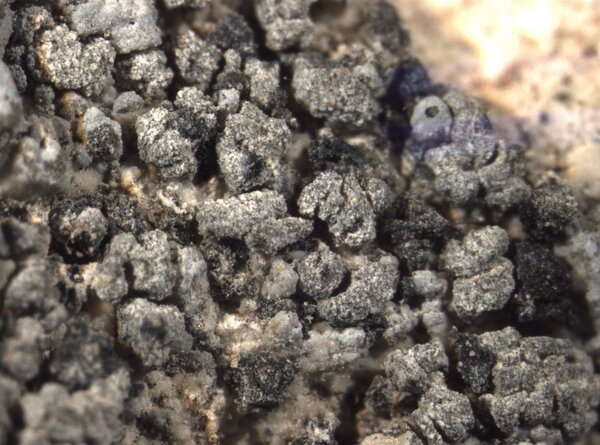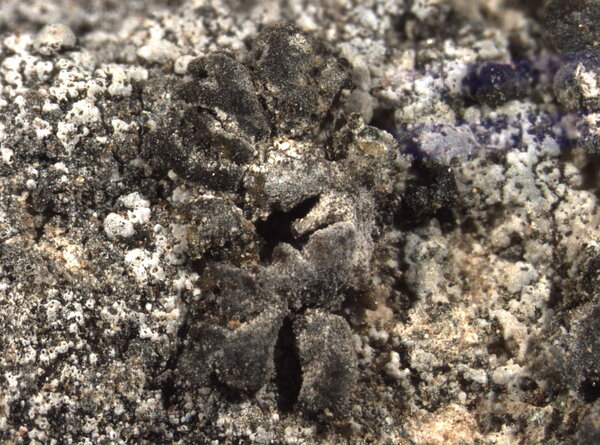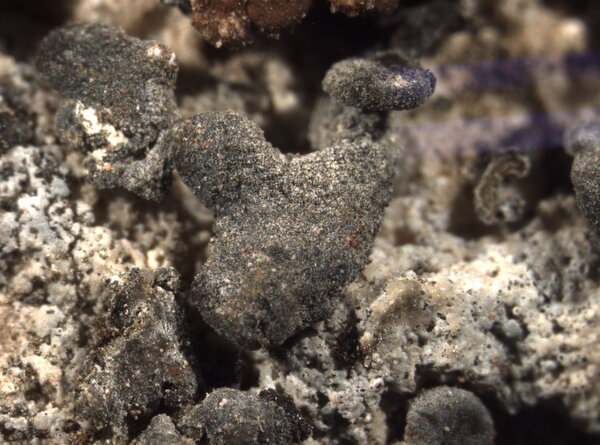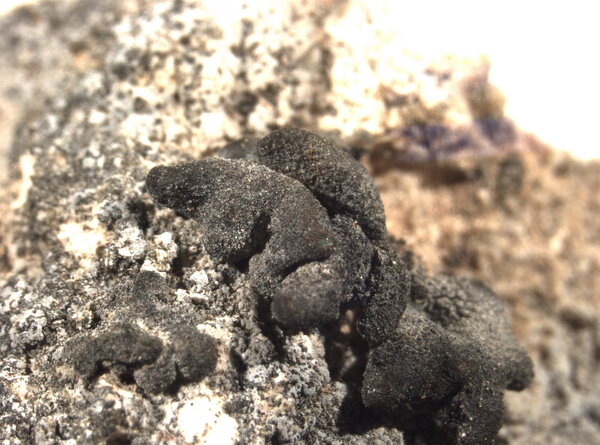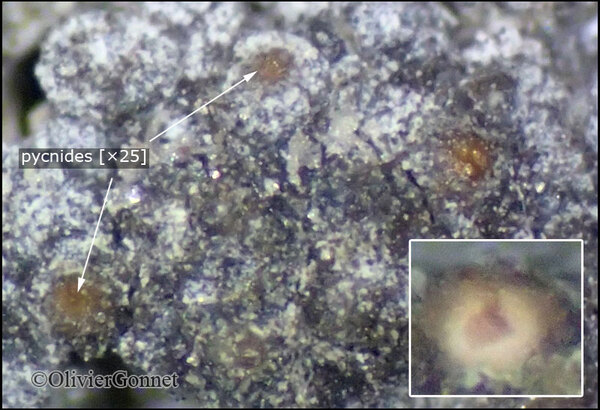Anema decipiens (A. Massal.) Forssell
N. Acta Reg. Soc. Sci. Upsal., ser. 3, 13: 92, 1885. Basionym: Omphalaria decipiens A. Massal. - Framm. Lichenogr.: 14, 1855.
Synonyms: Collema decipiens (A. Massal.) Nyl.; Thyrea decipiens (A. Massal.) A. Massal.
Distribution: N - VG (Tretiach 1993), Ven (Lazzarin 2000b), TAA, Lomb, Piem (Isocrono & al. 2004), Lig (S-F145460). C - Marc (TSB 33889), Abr (Jatta 1909-1911). S - Camp (Nimis & Tretiach 2004, Garofalo & al. 2010), Pugl, Si (Nimis & al. 1994, 1996b).
Description: Thallus squamulose, homoiomerous, slightly gelatinous when wet, in section with a loosely reticulate network of thin hyphae enclosing groups of cyanobacterial cells. Squamules 1-2 mm wide, brown-black to black, but usually blue-pruinose, with a mostly entire margin, dispersed to usually crowded and forming effuse crusts, with an entire to shallowly incised margin, covered in small, soredia- or isidia-like granules. Apothecia pycnoascocarps, 1-2 per squamule, at first immersed and urceolate, but soon expanded and clearly lecanorine, 0.3-0.5 mm across, with a dark reddish brown, concave to flat disc, and a thick, rugose, pruinose thalline margin. Proper exciple absent or very thin, cupular; epithecium orange-brown, thin; hymenium colourless, 100-150 µm high, the hymenial gel I+ deep blue; paraphyses in part simple, straight, long-celled, partly moniliform, 3-4 µm thick, the apical cell slightly swollen, up to 5 µm wide; hypothecium pale orange-brown, 20-50 µm high in central part. Asci 8-spored, broadly clavate, thin-walled, with a distinct amyloid outer cap, but no apical dome, Peccania-type. Ascospores 1-celled, hyaline, broadly ellipsoid to subglobose, 9-15 x 7-10 µm, the wall 1-2 µm thick. Pycnidia immersed, globose to pyriform, unilocular or later plurilocular, 70-140 µm wide. Conidia hyaline, ellipsoid to narrowly ellipsoid, 2.5-4 x 1.5-2 µm. Photobiont cyanobacterial, chroococcoid, of a few. 3-5 µm wide cells often penetrated by haustoria and surrounded by a gelatinous sheath which is colourless in inner parts, yellowish brown near the thallus surface. Spot tests: all negative. Chemistry: without lichen substances. Note: on steeply inclined, sunny surfaces of calcareous rocks (mainly limestone, but also calciferous schists and sandstone) with periodical water seepage after rain, below the subalpine belt. Probably widespread throughout the country.
Growth form: Crustose
Substrata: rocks
Photobiont: cyanobacteria, coccaceous (e.g. Gloeocapsa)
Reproductive strategy: mainly sexual
On otherwise dry surfaces with short periods of water seepage after rain
Commonnes-rarity: (info)
Alpine belt: absent
Subalpine belt: absent
Oromediterranean belt: absent
Montane belt: rare
Submediterranean belt: rather common
Padanian area: extremely rare
Humid submediterranean belt: rather rare
Humid mediterranean belt: rather rare
Dry mediterranean belt: rather rare

Predictive model
Herbarium samples
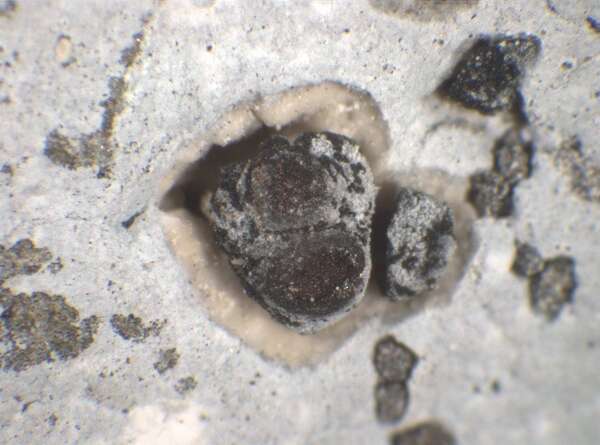

P.L. Nimis; Owner: Department of Life Sciences, University of Trieste
Herbarium: TSB (33890)
2003/03/11
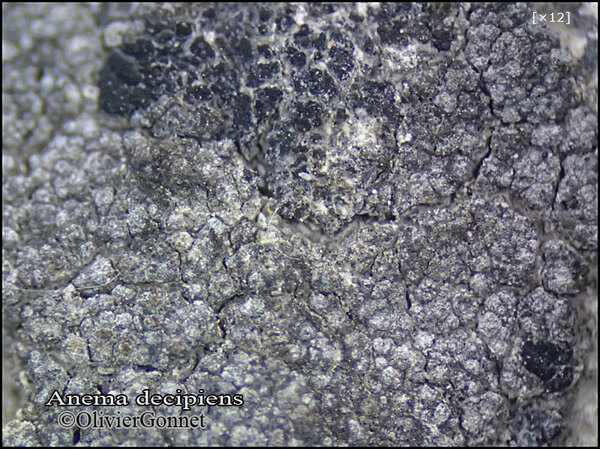
courtesy Olivier & Danièle Gonnet - Source: https://www.afl-lichenologie.fr/Photos_AFL/Photos_AFL_A/Textes_A3/Anema_decipiens.htm
France, Fort de l'Écluse, alt. 610 m - Léaz- Ain
9/10/2018

courtesy Olivier & Danièle Gonnet - Source: https://www.afl-lichenologie.fr/Photos_AFL/Photos_AFL_A/Textes_A3/Anema_decipiens.htm
France, Fort de l'Écluse, alt. 610 m - Léaz- Ain
9/10/2018
Growth form: Crustose
Substrata: rocks
Photobiont: cyanobacteria, coccaceous (e.g. Gloeocapsa)
Reproductive strategy: mainly sexual
On otherwise dry surfaces with short periods of water seepage after rain
Commonnes-rarity: (info)
Alpine belt: absent
Subalpine belt: absent
Oromediterranean belt: absent
Montane belt: rare
Submediterranean belt: rather common
Padanian area: extremely rare
Humid submediterranean belt: rather rare
Humid mediterranean belt: rather rare
Dry mediterranean belt: rather rare

Predictive model
| Herbarium samples |


P.L. Nimis; Owner: Department of Life Sciences, University of Trieste
Herbarium: TSB (33890)
2003/03/11

courtesy Olivier & Danièle Gonnet - Source: https://www.afl-lichenologie.fr/Photos_AFL/Photos_AFL_A/Textes_A3/Anema_decipiens.htm
France, Fort de l'Écluse, alt. 610 m - Léaz- Ain
9/10/2018

 INDEX FUNGORUM
INDEX FUNGORUM
 GBIF
GBIF
 DOLICHENS
DOLICHENS
